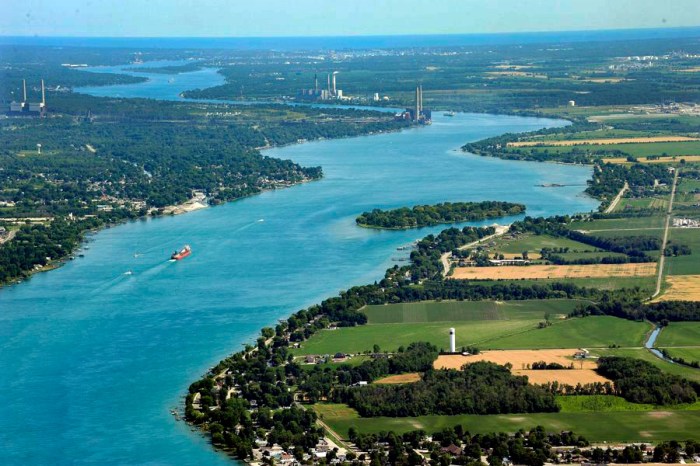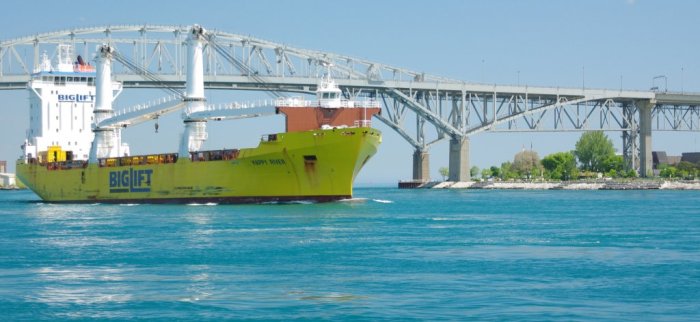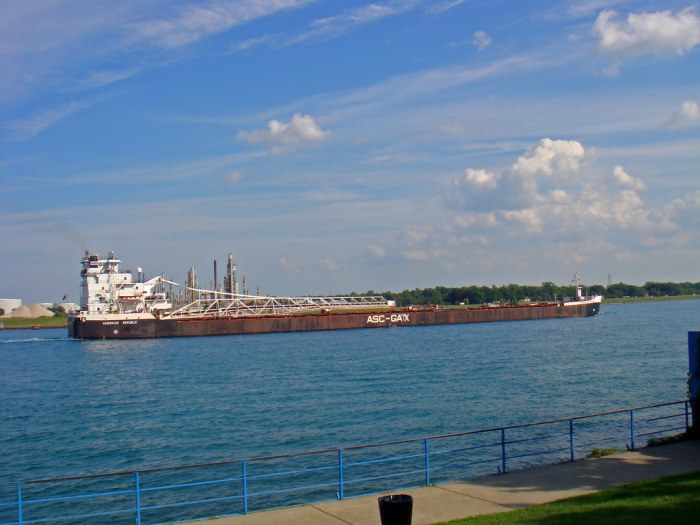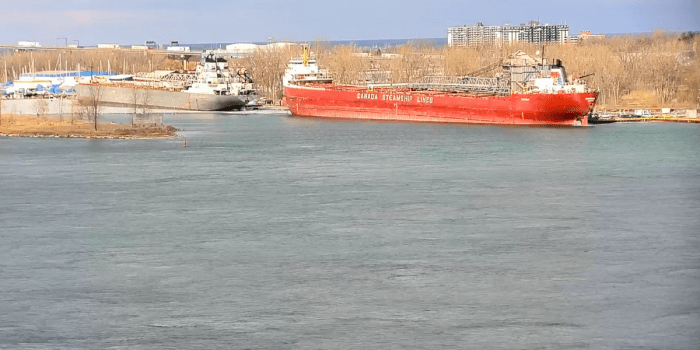Marine traffic st clair river – Delve into the captivating world of marine traffic on the St. Clair River, where the ceaseless flow of vessels paints a vibrant tapestry of economic, environmental, and historical significance. Join us as we navigate the complexities of this dynamic waterway, uncovering its impact on local industries, environmental stewardship, and the rich heritage that shapes its waters.
From bustling cargo ships to sleek pleasure crafts, the St. Clair River serves as a vital artery for trade, transportation, and recreation. Its strategic location at the heart of the Great Lakes region has made it a focal point of human activity for centuries, leaving an indelible mark on the surrounding communities and ecosystems.
Marine Traffic Patterns

The St. Clair River is a busy waterway, with a wide variety of marine traffic traversing its waters. These vessels include commercial ships, pleasure boats, and fishing vessels.
The volume and frequency of vessel movements on the St. Clair River vary depending on the season. During the summer months, there is a significant increase in recreational boating activity, as well as commercial shipping traffic.
Commercial Shipping
The St. Clair River is a major shipping route for the Great Lakes region. Commercial vessels carrying a variety of commodities, including iron ore, coal, and grain, transit the river on a regular basis.
The number of commercial vessels transiting the St. Clair River has increased steadily over the past decade. In 2021, over 10,000 commercial vessels passed through the river.
Recreational Boating
The St. Clair River is also a popular destination for recreational boaters. The river’s calm waters and scenic beauty make it an ideal place for boating, fishing, and swimming.
During the summer months, the St. Clair River is filled with pleasure boats of all sizes. The most popular boating activities include fishing, swimming, and tubing.
Economic Impact

The St. Clair River serves as a vital economic artery, facilitating the movement of goods and supporting numerous industries and businesses in the region.
The river’s strategic location at the crossroads of the Great Lakes system has played a significant role in the development of a robust marine transportation sector, generating substantial economic benefits for the communities along its shores.
The bustling marine traffic along the St. Clair River is a testament to the region’s industrial significance. Amidst the constant flow of vessels, one might ponder the complexities of welding, such as determining the polarity for TIG welding. For those curious about this topic, an informative article on what polarity is TIG welding provides valuable insights.
Returning to the river, the majestic freighters and tankers continue their journey, carrying vital goods to destinations far and wide.
Local Industries and Businesses, Marine traffic st clair river
Marine traffic on the St. Clair River supports a wide range of local industries, including:
- Manufacturing:The river provides a convenient and cost-effective means of transporting raw materials and finished goods for manufacturers in the region.
- Agriculture:The river supports the export of agricultural products, such as grains and soybeans, from the fertile farmlands of the Midwest.
- Tourism:The scenic beauty and recreational opportunities along the river attract tourists, boosting local businesses in the hospitality sector.
- Energy:The river plays a role in the transportation of fossil fuels and renewable energy sources, supporting the region’s energy needs.
Specific Companies
Several prominent companies rely on marine transportation via the St. Clair River, including:
- Ford Motor Company:The automaker utilizes the river to transport vehicles and components between its manufacturing facilities in Michigan and Ontario.
- Cargill:The agricultural giant operates grain terminals along the river, facilitating the export of crops from the Midwest.
- Blue Water Shipping:A leading provider of marine transportation services, Blue Water operates a fleet of vessels on the St. Clair River.
Environmental Considerations

Marine traffic on the St. Clair River poses potential environmental impacts that require careful consideration and mitigation measures.
The river’s ecosystem supports diverse wildlife, including endangered species like the lake sturgeon. Vessel traffic can disrupt their habitats, introduce invasive species, and increase water pollution.
Spill Prevention and Cleanup Protocols
- Strict regulations and protocols are in place to prevent oil spills and other hazardous material releases.
- Spill response plans are regularly updated and tested to ensure a rapid and effective response in the event of an accident.
- Emergency response teams are trained and equipped to contain and clean up spills, minimizing environmental damage.
Protecting the River’s Ecosystem
Preserving the St. Clair River’s ecosystem is crucial for the health and well-being of the region.
- Wildlife conservation measures include habitat restoration projects and monitoring programs to protect endangered species.
- Water quality is closely monitored and regulated to prevent pollution and maintain a healthy aquatic environment.
- Educational programs raise awareness about the importance of protecting the river and its ecosystem.
Infrastructure and Navigation

The St. Clair River boasts a well-developed infrastructure that supports a bustling marine traffic. Ports and terminals line the riverbanks, providing essential facilities for loading, unloading, and servicing vessels. Navigation aids, such as buoys, lighthouses, and radar systems, ensure safe and efficient navigation along the river’s course.
Challenges and Opportunities
Maintaining and improving this infrastructure is crucial to sustain the smooth flow of marine traffic. Challenges include the need for regular dredging to maintain adequate water depths, upgrades to navigation aids to enhance safety and efficiency, and investments in port facilities to accommodate larger vessels.
Opportunities exist in exploring innovative technologies, such as automated navigation systems, to further enhance safety and efficiency. Collaborations between stakeholders, including government agencies, industry partners, and local communities, are essential for effective infrastructure planning and management.
Navigation Regulations and Safety Protocols
A comprehensive set of navigation regulations and safety protocols governs marine traffic on the St. Clair River. These regulations are designed to prevent accidents, protect the environment, and ensure the orderly flow of vessels.
Key regulations include speed limits, traffic separation schemes, and pilotage requirements for certain vessels. Safety protocols encompass emergency response plans, spill prevention measures, and regular inspections of vessels and infrastructure.
Historical Significance: Marine Traffic St Clair River

The St. Clair River has played a significant role in the history of North America, serving as a vital waterway for exploration, trade, and transportation.
French explorers first arrived in the area in the 17th century, and the river became an important route for fur traders and missionaries. In the 18th century, the British gained control of the region, and the river became a strategic military outpost during the American Revolutionary War.
Role in Exploration
The St. Clair River was a key waterway for French explorers in the 17th and 18th centuries. Louis Jolliet and Jacques Marquette traveled down the river in 1673, becoming the first Europeans to explore the upper Mississippi River.
Role in Trade
The St. Clair River was an important route for fur traders in the 18th and 19th centuries. The river provided a direct connection between the Great Lakes and the Mississippi River, allowing traders to transport furs from the interior of North America to markets in Europe.
Role in Transportation
The St. Clair River became a major transportation route in the 19th and 20th centuries. The river was used to transport goods and passengers between the Great Lakes and the Mississippi River. In the 20th century, the river became an important route for shipping iron ore and other raw materials to industrial centers in the Midwest.
Tourism and Recreation
The St. Clair River is a popular destination for tourists and recreational enthusiasts alike. Marine traffic plays a vital role in supporting the tourism and recreation industry in the area.
Boating is one of the most popular activities on the river. There are numerous marinas and boat launches along the shoreline, making it easy for boaters to access the water. Fishing is also a popular pastime, with anglers targeting a variety of species, including walleye, perch, and bass.
Amenities and Facilities
In addition to boating and fishing, there are a number of other water-based activities available on the St. Clair River. These include swimming, kayaking, canoeing, and paddleboarding. There are also a number of parks and beaches along the shoreline, where visitors can relax and enjoy the scenery.
Clarifying Questions
What is the volume of marine traffic on the St. Clair River?
The St. Clair River is one of the busiest waterways in North America, with an average of over 40,000 vessel movements per year.
What types of vessels travel on the St. Clair River?
A wide variety of vessels traverse the St. Clair River, including cargo ships, tankers, barges, fishing boats, and pleasure crafts.
What is the economic impact of marine traffic on the St. Clair River?
Marine traffic generates significant economic benefits for the St. Clair River region, supporting local industries, businesses, and employment.